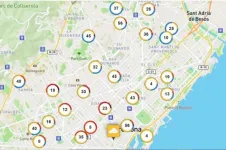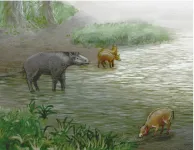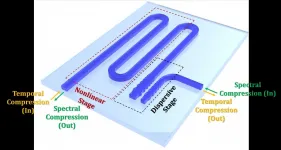New model shows how our social networks could contribute to generating economic phenomena
2021-07-06
(Press-News.org) Many standard economic models assume people make perfectly rational, individual decisions. But new research suggests economic phenomena like inequality and business cycles are better explained by models which recognize that people's decisions are affected by the decisions and the behaviors of people around them.
To show this, researchers built a model in which households are embedded in a social network that powerfully affects their savings decisions. This fairly simple model resulted in cyclical fluctuations resembling business cycles, as well as in emergent inequality - for instance, many poor households with low saving rates and a few rich households with high saving rates.
+++Substituting utility maximization in economic modelling with behaviorally grounded decision making+++
These results mirror behavior observable in the real world, but which standard economic models often fail to capture or explain, showing this more realistic approach to be an important alternative to classical economic modelling.
"We substitute utility maximization in economic modelling with behaviorally grounded decision making to provide a different perspective on problems such as economic growth," says Jakob Kolb, a former PhD student at the Potsdam Institute for Climate Impact Research (PIK) and one of the authors of the study now published in the Proceedings of the US National Academy of Sciences (PNAS). "Though the model we use is quite simple, it shows how we miss key insights into important economic phenomena if we model humans as rational decision-making machines rather than as deeply social beings."
In fact, the model makes the prediction that during recessions, saving rates increase before output rises - which fits observations for private savings in 19 OECD countries. "Hence, our approach seems to be quite realistic in this respect," says co-author Jobst Heitzig from PIK. "Next, we will use the social dynamics we analyzed here to model the re-allocation of capital from non-sustainable, CO2 intensive economic activities to more sustainable investments."
The researchers observed that when the social dynamics gets faster in their model, the inequality between households can very suddenly disappear, but if households copy their friends all too quickly, they might learn the wrong thing and stop saving altogether.
+++The picture of a man balancing a pole on his hand+++
The authors use the picture of man balancing a pole on his hand to illustrate the difference between their new model and older, conventional ones. "A standard macroeconomic model would posit that the man is a perfect pole balancer, and any deviations in the angle must be driven by external shocks, such as sharp gusts of wind," says co-author J. Doyne Farmer, Director of Complexity Economics at the Institute for New Economic Thinking, Oxford University. "On this view, after each shock the man moves his hand perfectly to make the pole vertical again but, before he can achieve this, another shock strikes, making the pole wobble. It is clear this explanation is wrong; theories that assume some of the pole's wobbles are due to the man's imperfect ability to balance the pole provide a far better explanation."
The study is also an example of successful promotion of young talent. Its first author Yuki Asano developed the model and found the main results during his Bachelor thesis work at PIK, supervised by Jakob Kolb and Jobst Heitzig. Asano then moved on to do his PhD at Oxford University where the writing of the paper gained the support of Doyne Farmer, a pioneer of chaos theory who also spent a few years at PIK in the 2010s.
INFORMATION:
Article: Yuki M. Asano, Jakob J. Kolb, Jobst Heitzig, J. Doyne Farmer (2021): Emergent inequality and business cycles in a simple behavioral macroeconomic model. Proceedings of the National Academy of Sciences (PNAS) [DOI:0.1073/pnas.2025721118]
Weblink to the article: https://www.pnas.org/content/118/27/e2025721118/tab-article-info
ELSE PRESS RELEASES FROM THIS DATE:
2021-07-06
* Clinical trial at University of Warwick compares the familiar cast, traditionally signed in sympathy, to modern removable brace for immobilising broken ankles
* Cast was not more effective, with patients reporting similar levels of pain and functionality, suggesting that choice should be down to patient preference and cost effectiveness
* Some data suggested a patient preference for the removable brace - sometimes referred to as the 'Beckham boot' after David Beckham
Using a cast is not more effective than a brace for treating broken ankles, according to University ...
2021-07-06
An elegant new algorithm developed by Danish researchers can significantly reduce the resource consumption of the world's computer servers. Computer servers are as taxing on the climate as global air traffic combined, thereby making the green transition in IT an urgent matter. The researchers, from the University of Copenhagen, expect major IT companies to deploy the algorithm immediately.
One of the flipsides of our runaway internet usage is its impact on climate due to the massive amount of electricity consumed by computer servers. Current CO2 emissions ...
2021-07-06
Medical researchers at Ludwig-Maximilians-Universitaet (LMU) in Munich have uncovered how signal proteins of the immune system regulate the development of atherosclerosis.
Atherosclerosis is one of the most common causes of death in Germany. The condition is characterized by the build-up of cholesterol and other fatty metabolites in the arterial wall directly below the endothelial cell layer, which is in direct contact with the bloodstream. This process results in constriction of the artery, which obstructs blood flow and can trigger heart attacks and strokes. Atherosclerosis is generally treated with drugs that reduce the concentration of lipids in the circulation, often using compounds called statins. However, statins effectively reduce the risk of cardiovascular ...
2021-07-06
Dysmenorrhea, that is, frequent severe and painful cramps during menstruation from abnormal contractions of the uterus, is the most common of all gynecological disorders. It affects between 16-91% of girls and women of reproductive age, of whom 2%-29% have symptoms severe enough to restrict their daily activity. Now, for the first time, researchers from China Medical University Hospital in Taiwan have shown that long-term exposure to air pollutants such as nitrogen and carbon oxides and fine particulate matter greatly raises the risk of developing dysmenorrhea. Based on long-term data on air quality and public health from national databases, they show that the risk to develop dysmenorrhea ...
2021-07-06
A study led by University of Barcelona researchers and carried out together with more than 1,650 students and their family members from 18 educational centres in Barcelona shows that citizen science is a valid approach able for doing high quality science, and in this case, able to provide nitrogen dioxide values with an unprecedented resolution and to assess the impact of the pollution in the health of their inhabitants.
The journal Science of the Total Environment has published the results of a study carried out by the research group OpenSystems of the University of Barcelona, the Barcelona Institute for Global Health (ISGlobal), promoted by La Caixa Foundation ...
2021-07-06
Participants at the 6th Joint Science Conference of the Western Balkans Process have developed a "10 Point Plan" to control the coronavirus pandemic in the Western Balkans. Participants at the virtual two-day meeting also discussed priorities for the time after the pandemic in the Western Balkans and South East Europe. These include a decent healthcare system, climate neutrality, reduction of air and water pollution, and the digitalization of education, public administration, industry and healthcare. The conference was jointly organized by the German National Academy of Sciences Leopoldina and the Polish Academy of Sciences as part of the Western Balkans ...
2021-07-06
Although hypomorph mammals (or equids) are currently represented by only one genus ('Equus') and just a handful of species of horses, donkeys and zebras, they were more diverse during the Eocene epoch (between 56 and 33.9 million years ago). One of the most widespread groups in Europe, which was an archipelago at that time, were the palaeotheriidae, named after the genus 'Palaeotherium', described in 1804 from fossils originating in the quarries of Montmartre (Paris) by the famous French naturalist George Cuvier.
The international Journal of Vertebrate Paleontology has recently published a paper on a study led by Leire Perales-Gogenola describing two new species of palaeotheriidae mammals that inhabited the subtropical landscape of Zambrana (Álava) ...
2021-07-06
Big hydropower plants are an important source of clean and cheap electricity for many countries in Southeast Asia. However, dams harm the environment and have dire consequences on local communities. Building more dams would therefore pose major trade-offs between electricity supply and environmental protection.
A team of scientists based in Singapore showed that these two challenges can be decoupled. Their study, titled "Solar energy and regional coordination as a feasible alternative to large hydropower in Southeast Asia", recently published in Nature Communications, showed that there are more sustainable pathways to a clean energy future (refer to figure below).
Building on high resolution mathematical models of the Thai, Laotian, and Cambodian ...
2021-07-06
Researchers from Skoltech and the Mental Health Research Center have found 22 lipids in the blood plasma of people with schizophrenia that were associated with lower symptom improvement over time during treatment. These can help track resistance to medication that affects over a third of patients. The paper was published in the journal Biomolecules.
Studies suggest that up to 34% of people living with schizophrenia can be resistant to two or more antipsychotic medications used to treat the disorder. Individual responses vary greatly, and there are no satisfactory biomarkers of treatment response yet, which can often turn finding the right medication into a painful ...
2021-07-06
TAMPA, Fla. (July 6, 2021) - All it takes is three consecutive nights of sleep loss to cause your mental and physical well-being to greatly deteriorate. A new study published in Annals of Behavioral Medicine looked at the consequences of sleeping fewer than six hours for eight consecutive nights - the minimum duration of sleep that experts say is necessary to support optimal health in average adults.
Lead author Soomi Lee, assistant professor in the School of Aging Studies at the University of South Florida, found the biggest jump in symptoms appeared after just one night of sleep loss. The number of mental and physical problems steadily got worse, peaking on day three. At that point, research shows the human body got relatively used to repeated sleep loss. But that all ...
LAST 30 PRESS RELEASES:
[Press-News.org] New model shows how our social networks could contribute to generating economic phenomena



